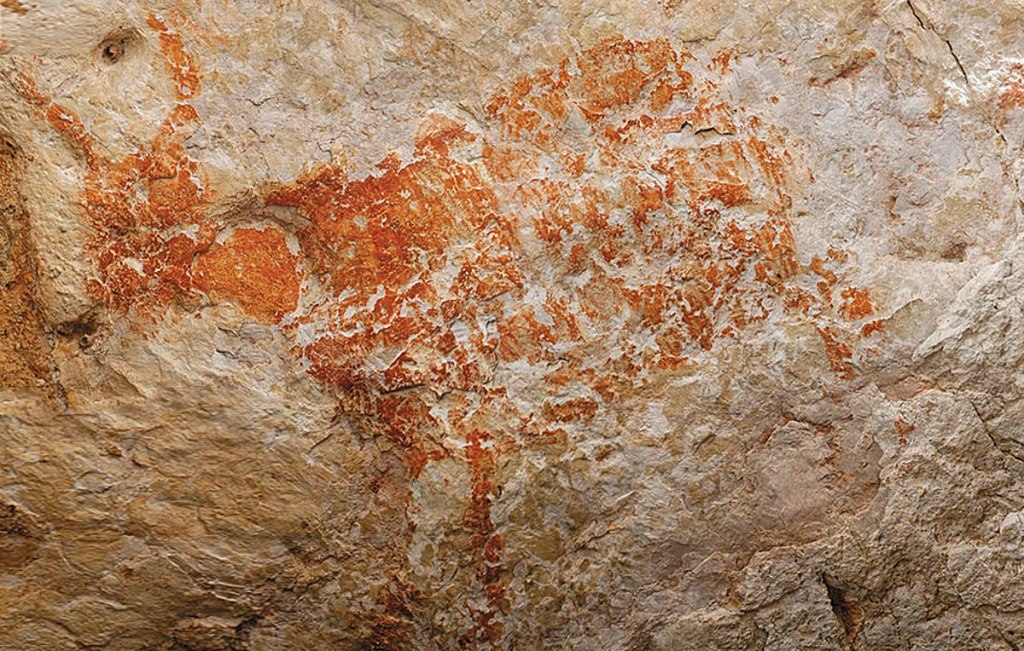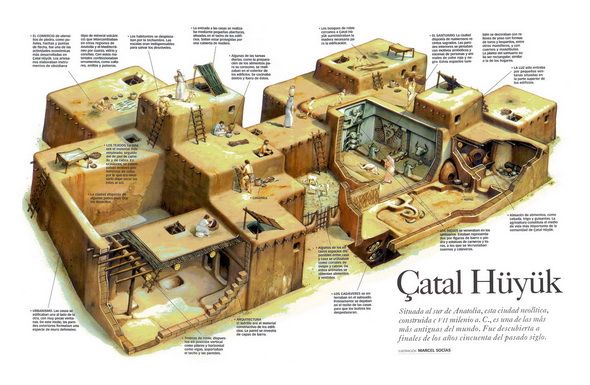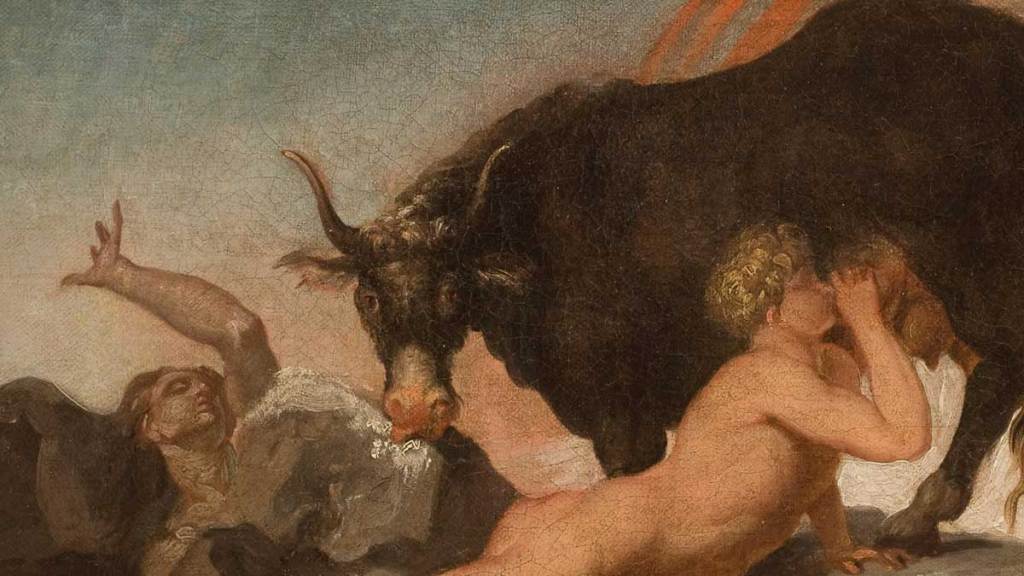
Holy Cow: A look at sacred cows in Viking myth, Hindu Religion, and the American midwest.
A Single Mom in Wisconsin
My two youngest sons, nine-year-old Malcolm and six-year-old William get up in the morning, ask me for a bagel. This is fine, I’ll cut a bagel in half, feed both of them (I figured out that when I give them each a bagel I wind up later finding two jagged half-eaten bagel fossils in the couch cushions – which can be a painful discovery!).
In my house, dropping a bagel into a toaster, waiting forty seconds and then spreading something on it counts as “making a bagel,” as if I sowed, reaped and ground the flour, shaped and baked it. My sons think I’m a magician, when really I’m just the toaster’s lovely assistant. It’s a magician that -presto- makes a cold roll disappear and then -presto- a warm bagel materialize out of thin air! And I just stand there looking pretty. Or I guess I’m kind of a mathe-magician, who can turn one bagel into two by cutting it in half. Behold! Division is actually multiplication! Subtraction transformed to addition!
My sister is an Episcopal priest. Right now she’s conducting a service, performing the miracle of transubstantiation, turning crackers into the body of Christ. I can’t do that, but I can transform one bagel into two breakfasts. I can break the body of crust, the bread of leaven into a communion. As long as the eaters are small.
Anyway, Malcolm wants cream cheese and William wants butter. Malcolm won’t touch a bagel with butter. To him that’s not a bagel at all, and William feels the same way about cream cheese. Same lactose, but a religious-level intolerance. If Malcolm eats his half and wants more, I point to the stub William didn’t finish, say “first eat that, then we’ll talk,” he says “No! That’s a William bagel!” It’s like some kind of treasonous traitor, gone over to the other side, it can never come back, never be a Malcolm-bagel.
What’s up with these two? Same parents, same house, same crazy hairstyle, we still put them together in the same bathtub, but these little preferences make them feel as if they’re completely different. And they demand that their individuality be honored: each wants something that was intentionally and exclusively made for only him. Which is funny to me, the guy who just cut the same bagel in half. But each side has been transformed, personalized into a one-of-a-kind gift for a unique individual. Some people might hear this and say “that’s what makes you a good parent.” If you’re thinking that, it’s because you can’t read my mind and hear how many time I think “this is ridiculous. It’s food, just eat it so you can get on with your life. It all looks the same at the other end, then you flush and it’s gone forever.” I feed my kids because hungry children bother and annoy and interrupt me. So if I want a moment of peace to obsess about whatever thing I’m obsessing about (usually myself), first I’ve gotta preemptively silence the interruptions.
What these two have in common – the same parents who work to earn the food so we can work again to prep and serve it. Both fed by the “amber waves of grain” and the “fruited plain,” the heartland of this country. Butter and cream cheese that, for all we know, may have come from the same cow, an abundant wet-nurse whose body makes food for her own offspring but on top of that (think about it) this bovine single mom in Wisconsin is willing to breastfeed three hundred and thirty million human Americans! Can you imagine that? You and me? Foster-siblings, adopted and nurtured by the same cow, whom we’ve never even met! But she put the cream in my coffee and the milk in your raisin-bran.
The Painted Cow
The cow is part of some English phrases that are currently fading out of usage. Nobody says “Holy Cow” much anymore. Apparently this expression comes from baseball radio announcers (one of whom was hiding in the back seat during Meat Loaf’s “Paradise by the Dashboard Light”). I guess old-time fans huddled by radios just needed something really big and improbable to envision during a hit they couldn’t see: “Bases loaded, strike one, strike two, holy cow!” As if the calfskin ball had come back to life and this super-cow jumped over the moon!
There’s the old phrase “Sacred Cow,” meaning someone’s personal hobby-horse… Well, come to think of it, nobody says “hobby horse” much anymore either. Expressions beginning with “bull” are still around and doing fine. But “Holy Cow” and “Sacred Cow” are both facing extinction. Which is interesting, because the cow figures in some of humanity’s earliest and most enduring symbolism.

Cattle were popular subjects for Paleolithic cave-painters. These were the millennia before farms and fences, when humans were migratory foragers and cattle were free range. Leaner and meaner than their modern mutant descendants, they were fearsome beasts, individually formidable and on a communal stampede unstoppable. But! If you managed to kill one you could throw the biggest party of the year! Our English word “Carnival” still reflects this, since it used to be such a rare celebratory event when everybody got to eat “carne” (meat).
The oldest known cave painting is a cow in Borneo that someone etched in red ochre forty thousand years ago. There are also twenty-thousand year old examples painted in the caves of France and other locations in Europe. These caves were not public art galleries – they were deep, dark and dangerous to access. Some archaeologists say that cave etching came from a belief that humans could descend into the womb of the earth and fertilize it with symbolic images so that animals would be born.
The earliest known experiment with city-building was nine thousand years ago in Anatolia, what we now call Turkey. It housed thousands of people in multi-story apartment complexes, and excavators have identified one of its inner chambers as a temple. In this cave-like room, bull skulls with plaster features were affixed to the walls. We don’t know why, but it’s likely a parallel with earlier traditions of etching cattle in caverns.

Statues and carvings of cattle are also found in the oldest settlements of the Indus Valley, in what we now call India, where a matriarchal metropolis arose five thousand years ago. This civilization conducted the first known experiments with indoor plumbing. This culture used the heifer and bull as symbols of fertility and virility. It flourished for two thousand years, then fell (maybe invaded by Aryan barbarians) but the cow continues to be venerated in India. Hinduism forbids the slaughter and consumption of beef. And cattle cannot be owned – they are free to wander in India, producing milk and butter-oil that play important roles in Hindu rituals.
When we think about sacred cattle in ancient religions, one of the first stories to come to mind might be the famous “Golden Calf” fiasco in the Biblical book of Exodus. When the liberated Hebrews have escaped from Egypt, and Moses climbs the mountain to receive the Law, the people gather and demand a god statue that they can pray to for provision as they cross the barren lifeless desert. They take up a collection and melt down their gold to produce the likeness of a calf. Of course the story ends in disaster – Moses comes down from the mountain, crushes the statue to powder, adds water and makes the people drink it. But regardless of crime and punishment, it’s interesting to note that when the Hebrews wanted a shape to pray through, the image that came to mind was a sacred cow.
There are many other examples of holy cows in religions throughout the Middle East, Europe and Asia. As an old expression goes, we could keep listing these “till the cows come home.” There is also cattle’s North American cousin, the bison, who plays a significant role in indigenous spiritualities of the Great Plains. Natives of the Midwest believe that the plains belong to the Buffalo, who host the human population, providing food, clothing, shelter (in the form of bison-hide tents called tipis) and bone tools. And in exchange for this hospitality, humans can conduct religious rituals encouraging rainfall and grass growth to feed the bison populations in return.

Most ancient traces of cattle veneration are mysterious etchings and carvings from ancient cultures whose stories have been lost in the shifting sands of time. Oddly enough, it’s the Vikings who preserve one of the oldest known cow myths in print. Norsemen were surly pirate-types (even the word “Vik” means “to pillage,” so “Viking” was an epithet for dangerous sea-faring raiders). But the 13th Century text known as the “Prose Edda” contains a story about the beginning of the earth. In a place between fire and ice, a cow called Auðumbla stood, licking a large lump of salt. She secreted four streams of milk, and nursed the frost giant Ymir. And as she licked away at the salt, she found some hairs on her tongue. Licking further she revealed the head, then the body, of Buri, the grandfather of the great Norse sky-gods.
Well, then the story turns pretty Viking – the sky gods kill and dismember the frost-giant, making land from his flesh and mountains from his bones, clouds from his brains, oceans from his blood and the sky from his skull. Eventually one of the frost giants gets revenge – Loki is adopted by the sky gods and his trickery triggers the apocalyptic Ragnarok. It’s a brutal, nasty story from a culture that basked in bloody violence. The cow is quickly forgotten. Which is too bad, because for one shining moment there, it was this cow that nurtured both of these ancient enemies: feeding the frost giant and freeing the sky god from a block of salt. She is a symbol of maternal warmth, and her generosity is not bounded by either side of this cosmic struggle for control.
Why all this ancient enmity anyway? Who knows? Maybe the sky-god liked butter and the frost giant liked cream cheese.
Conclusion
It’s hard, today, to think of the cow as something sacred, worthy of reverence. We’ve spent thousands of years selectively breeding the fattest, dumbest cows to the slowest, stupidest bulls – our agricultural science is based on un-natural selection. We’ve made the cow totally dependent on us. And we’ve developed a dangerous dependence on beef. Now it turns out, cattle flatulence might be more hazardous than fossil fuels, and cheap hamburgers might be more addictive than opium. The industrialization of harvesting milk and meat is horrific. The modern cow is more like a plant than an animal. When we contemplate our modern relationship with cattle there’s a lot to feel bad about.
But -spoiler alert- this message isn’t going to end with me telling you to go cry over spilled milk.
It’s fascinating to look at how many cultures share a respect for the cow as a symbol of abundance and generosity. It generates goodness. A cow can feed creatures as different as calves and humans, Malcolm and William, and can inspire religions as diverse as peaceful Hindus and violent Vikings. There’s something universal about the cow – it even seemed like it could make for the topic of a really easy Unitarian sermon! Too late I realized that we since we don’t all have meat and milk in common, I’d need to come up with an ending that had a vegan option..
It’s never a compliment to call someone, or be called, a cow. It’s not a symbol of ambition and intellect. It’s just a symbol of unquestioning, non-judgmental generosity.
But you know? Maybe there’s some wisdom in that.
(More info at j-snodgrass.com)
